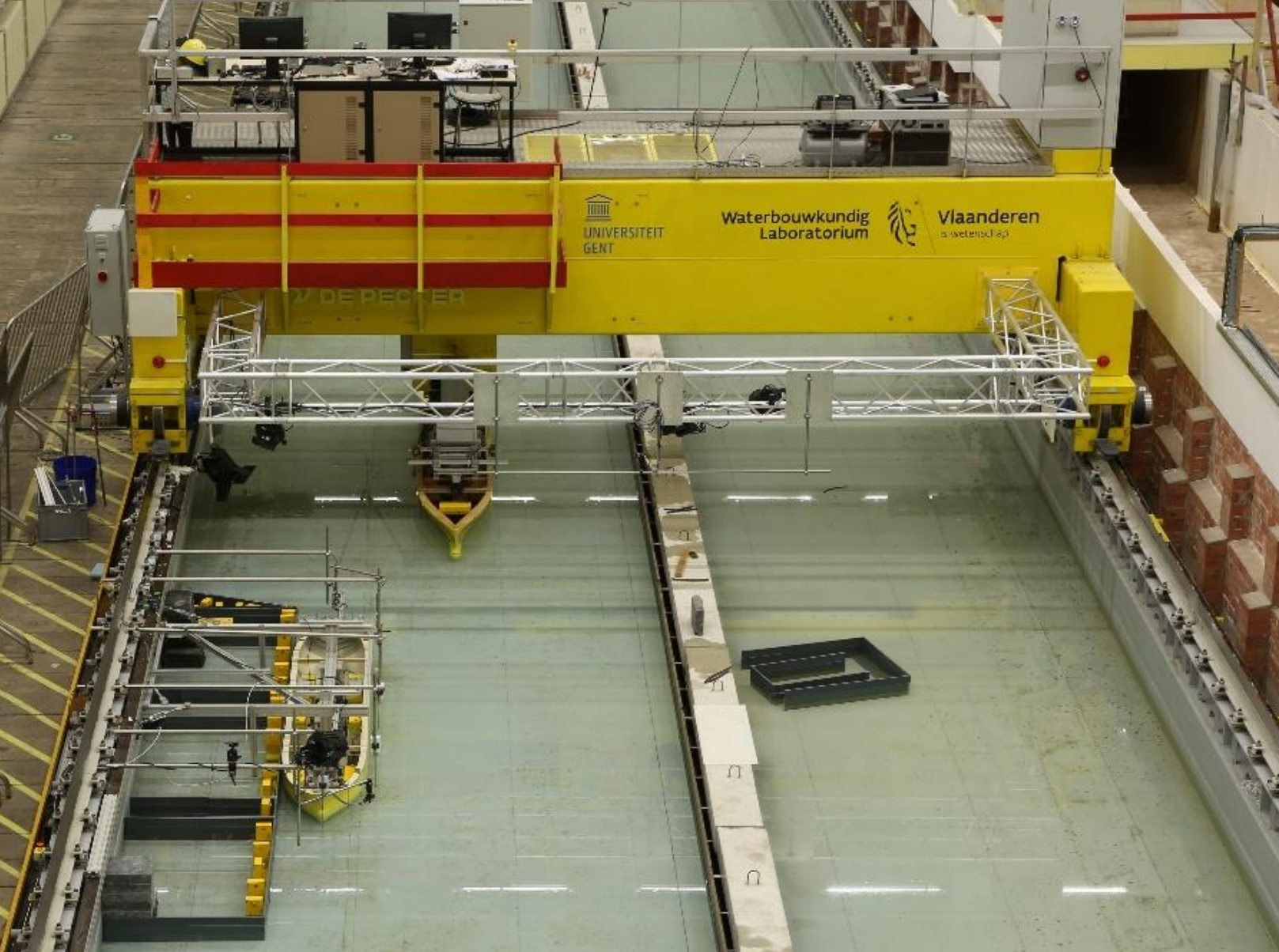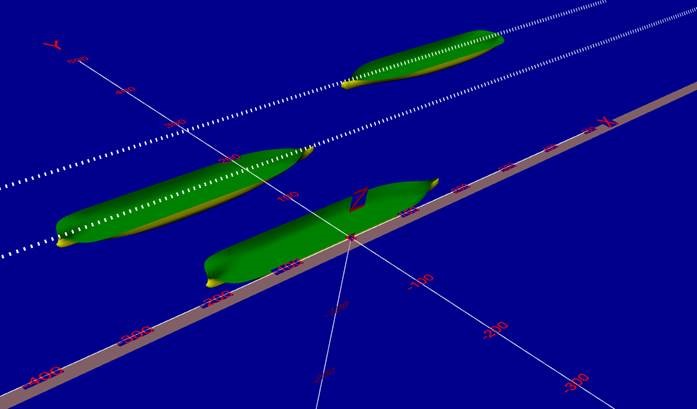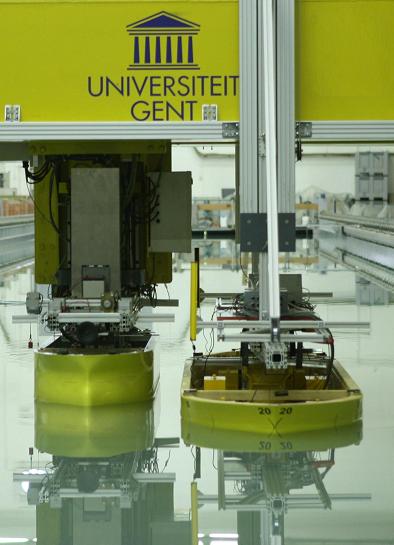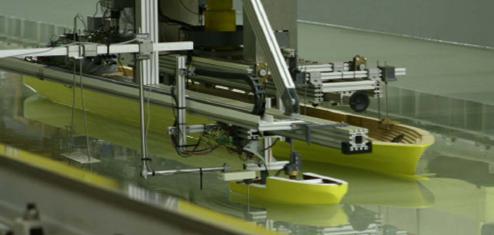Ship to ship interaction
PESCA (Passing Effects in Shallow and Confined Areas)

Since ships (gas carriers, RoRo, container ships) are getting larger, passing events become increasingly critical for existing channel dimensions. Numerical predictions reach their limitations in these cases. In order to produce a mathematical model to cope with these conditions, a dedicated model test program has been performed at Flanders Hydraulics Research in spring 2019, called PESCA (Passing Effects in Shallow and Confined Areas). The regression model based on these systematic tests will aid the department in accurately predicting passing ship forces, in today's but also in future cases.
Incident cases where the moored ship's lines rendered and/or broke have been examined in detail, exposing the reasons for this unwanted event to occur. Rendering winches, as well as breaking lines were modelled in the software, as well as the tugs which were assisting in keeping the vessel moored. Literature and informal discussions also reveal that issues with mooring operations and/or inadequate mooring equipment can lead to safety being compromised. Examples here are absence of pretension / slack in lines and use of very elastic lines (Van Zwijnsvoorde et al. (2019)).
ROPES (Research On Passing Effects of Ships)
.jpg)
The Knowledge Centre has been contacted by the Antwerp Port Authority to study the effect of passing ships on moored ships in the Deurganck dock. When the largest lock in the world, the Kieldrecht lock, will officially be inaugurated in June 2016, ships will sail through the Deurganck dock to reach the Waaslandhaven. As a consequence, RoRo vessels, bulk carriers, container ships and tankers will pass moored container ships. As the width of the dock is restricted and container ship sizes still tend to increase, the passing distance is limited. Passing ships exert forces on the moored ships, which are transferred to the mooring system. It is important that the mooring lines and fenders are strong enough to cope with these forces. Moreover, the induced motions should not disturb loading and unloading operations.

Several passages were simulated using the dedicated software package Ropes to calculate the forces on moored vessels. Different configurations were simulated ranging from the passage of a single RoRo vessel at the centerline of the dock to the meeting of two 18000 TEU container ships in the dock, every simulation considering a moored vessel at each side of the dock. Based on existing mooring configurations and the forces predicted by Ropes, the motions of the moored vessels were calculated using the software package Vlugmoor which has specifically been developed by the Division of Maritime Technology at Ghent University for this purpose.
The numerical results were compared with PIANC guidelines with respect to acceptable ship motions and the allowable forces in the mooring lines and fenders. The results of the study, which contain recommendations for passing ships, are being communicated to the river pilots by the Antwerp Port Authority and generally appear to match the intended speed ranges the pilots have in mind for a safe passage in the given studied situations.
Cargo Transfer

Applications of ship-to-ship interaction for the transfer of liquid cargoes such as oil and LNG will greatly increase in the future. It is expected that these complex operations will increasingly take place under adverse weather conditions. In order to better understand the hydrodynamic effects, which are of great importance to these manoeuvres, a research project entitled Investigating hydrodynamic aspects and control strategies for ship-to-ship operations was set up, co-ordinated by MARINTEK (Trondheim, Norway) and financially supported by the Research Council of Norway.
The principal objective of this research project is that of improving the current ship-to-ship interaction training on ship manoeuvring simulators by enhancing the knowledge of the complex flows arising between vessels that sail closely to each other.
Within the scope of this research model tests have been carried out in the Towing Tank for Manoeuvres in Shallow Water. A model of an Aframax tanker was attached to the PMC of the towing tank, whilst a VLCC model was directly connected to the towing carriage. Forces, moments and displacements were accurately measured on both ship models. The water surface was monitored by three wave gauges. In May 2011 the 2nd International Conference on Ship Manoeuvring in Shallow and Confined Water with emphasis on this topic was also organised in Trondheim, Norway. A paper about the experiments and entitled "Ship to ship interaction forces during lightering operations" by Lataire et al. was presented at the conference.
Ship - Tugboat Interaction

When a tugboat is close to the bow of a container ship, its dynamic behaviour and controllability will substantially change. Tests were carried out with models in the Towing Tank for Manoeuvres in Shallow Water in order to determine these effects and their interdependencies. For a clear understanding of the physical phenomena arising in the proximity of a container ship and a tugboat, the flow around the container ship and tugboat has been registered. Based on the measurements from the towing tank, a numerical model will be validated in order to improve the prediction of motion behaviour. A paper describing the experiments and entitled "Interaction forces in tug operations" by Geerts et al. was presented in May at the 2nd International Conference on Ship Manoeuvring in Shallow and Confined Water
